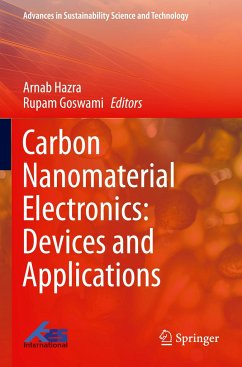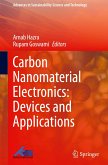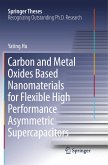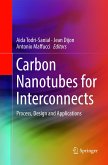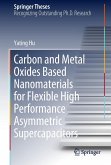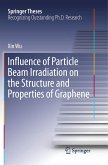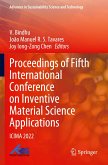Carbon Nanomaterial Electronics: Devices and Applications
Herausgegeben:Hazra, Arnab; Goswami, Rupam
Carbon Nanomaterial Electronics: Devices and Applications
Herausgegeben:Hazra, Arnab; Goswami, Rupam
- Broschiertes Buch
- Merkliste
- Auf die Merkliste
- Bewerten Bewerten
- Teilen
- Produkt teilen
- Produkterinnerung
- Produkterinnerung
This book brings together selective and specific chapters on nanoscale carbon and applications, thus making it unique due to its thematic content. It provides access to the contemporary developments in carbon nanomaterial research in electronic applications. Written by professionals with thorough expertise in similar broad area, the book is intended to address multiple aspects of carbon research in a single compiled edition. It targets professors, scientists and researchers belonging to the areas of physics, chemistry, engineering, biology and medicine, and working on theory, experiment and applications of carbon nanomaterials.…mehr
Andere Kunden interessierten sich auch für
![Carbon Nanomaterial Electronics: Devices and Applications Carbon Nanomaterial Electronics: Devices and Applications]() Carbon Nanomaterial Electronics: Devices and Applications117,99 €
Carbon Nanomaterial Electronics: Devices and Applications117,99 €![Carbon and Metal Oxides Based Nanomaterials for Flexible High Performance Asymmetric Supercapacitors Carbon and Metal Oxides Based Nanomaterials for Flexible High Performance Asymmetric Supercapacitors]() Yating HuCarbon and Metal Oxides Based Nanomaterials for Flexible High Performance Asymmetric Supercapacitors74,99 €
Yating HuCarbon and Metal Oxides Based Nanomaterials for Flexible High Performance Asymmetric Supercapacitors74,99 €![Carbon Nanotubes for Interconnects Carbon Nanotubes for Interconnects]() Carbon Nanotubes for Interconnects74,99 €
Carbon Nanotubes for Interconnects74,99 €![Carbon and Metal Oxides Based Nanomaterials for Flexible High Performance Asymmetric Supercapacitors Carbon and Metal Oxides Based Nanomaterials for Flexible High Performance Asymmetric Supercapacitors]() Yating HuCarbon and Metal Oxides Based Nanomaterials for Flexible High Performance Asymmetric Supercapacitors74,99 €
Yating HuCarbon and Metal Oxides Based Nanomaterials for Flexible High Performance Asymmetric Supercapacitors74,99 €![Physics and Chemistry of Carbon-Based Materials Physics and Chemistry of Carbon-Based Materials]() Physics and Chemistry of Carbon-Based Materials125,99 €
Physics and Chemistry of Carbon-Based Materials125,99 €![Influence of Particle Beam Irradiation on the Structure and Properties of Graphene Influence of Particle Beam Irradiation on the Structure and Properties of Graphene]() Xin WuInfluence of Particle Beam Irradiation on the Structure and Properties of Graphene74,99 €
Xin WuInfluence of Particle Beam Irradiation on the Structure and Properties of Graphene74,99 €![Proceedings of Fifth International Conference on Inventive Material Science Applications Proceedings of Fifth International Conference on Inventive Material Science Applications]() Proceedings of Fifth International Conference on Inventive Material Science Applications147,99 €
Proceedings of Fifth International Conference on Inventive Material Science Applications147,99 €-
-
-
This book brings together selective and specific chapters on nanoscale carbon and applications, thus making it unique due to its thematic content. It provides access to the contemporary developments in carbon nanomaterial research in electronic applications. Written by professionals with thorough expertise in similar broad area, the book is intended to address multiple aspects of carbon research in a single compiled edition. It targets professors, scientists and researchers belonging to the areas of physics, chemistry, engineering, biology and medicine, and working on theory, experiment and applications of carbon nanomaterials.
Produktdetails
- Produktdetails
- Advances in Sustainability Science and Technology
- Verlag: Springer / Springer Nature Singapore / Springer, Berlin
- Artikelnr. des Verlages: 978-981-16-1054-7
- 1st ed. 2021
- Seitenzahl: 456
- Erscheinungstermin: 24. Mai 2022
- Englisch
- Abmessung: 235mm x 155mm x 25mm
- Gewicht: 686g
- ISBN-13: 9789811610547
- ISBN-10: 9811610541
- Artikelnr.: 63902148
- Herstellerkennzeichnung
- Books on Demand GmbH
- In de Tarpen 42
- 22848 Norderstedt
- info@bod.de
- 040 53433511
- Advances in Sustainability Science and Technology
- Verlag: Springer / Springer Nature Singapore / Springer, Berlin
- Artikelnr. des Verlages: 978-981-16-1054-7
- 1st ed. 2021
- Seitenzahl: 456
- Erscheinungstermin: 24. Mai 2022
- Englisch
- Abmessung: 235mm x 155mm x 25mm
- Gewicht: 686g
- ISBN-13: 9789811610547
- ISBN-10: 9811610541
- Artikelnr.: 63902148
- Herstellerkennzeichnung
- Books on Demand GmbH
- In de Tarpen 42
- 22848 Norderstedt
- info@bod.de
- 040 53433511
Arnab Hazra received his M.Tech. and Ph.D. from Indian Institute of Engineering Science and Technology (IIEST), Shibpur, India, in 2011 and 2015, respectively. Presently, he is an Assistant Professor in the Department of Electrical and Electronics Engineering, Birla Institute of Technology and Science (BITS), Pilani, Rajasthan, India. He worked as a visiting scientist at Tel Aviv University, Israel and Sensor Laboratory, University of Brescia, Italy in 2018. His current research interest includes nanoscale materials based devices for gas sensing and memristive applications and 2D materials based field effect devices. He has published about seventy research articles in the journals and conferences of international repute, two book chapters and received two Indian patents. He received best Ph.D. thesis award by Indian National Academy of Engineering (INAE) and ISSS, India, in 2015 and 2016, respectively. He also received IEI young engineer award by the Institute of Engineers, India, in 2016. Rupam Goswami obtained his M.Tech. in 2014, and Ph.D. in 2018 from National Institute of Technology Silchar. India. Currently he is an Assistant Professor at the Department of Electronics and Communication Engineering, School of Engineering, Tezpur University, India. Before joining Tezpur University, he worked as an Assistant Professor at Birla Institute of Technology and Science Pilani, Rajasthan, India. His research interests include simulation and modeling of TFETs, HEMTs, FinFETs, and memristors. He has published his work in 2 books, 16 international peer-reviewed journals, and 13 international peer-reviewed conferences.
Chapter 1. Introduction.- Part 1: Synthesis and characterizations.- Chapter 2. Synthesis of carbon allotropes in nanoscale regime.- Chapter 3. Scanning tunneling microscopy (STM) imaging of carbon nanotropes: C60, CNT and Graphene.- Chapter 4. Carbon: A phantom for nanocomposite driven applications.- Chapter 5. Carbon-Based Nanocomposites: Processing, Electronic Properties And Applications.- Chapter 6. Tuning of SPR and Structural Properties of Cu-fullerene metal nanocomposites.- Part 2: Theoretical and computational study.- Chapter 7. Theoretical and Computational Investigations of Carbon Nanostructures.- Chapter 8. Edge State Induced Spintronic Properties of Graphene Nanoribbons: A Theoretical Perspective.- Chapter 9. Carbon Nanotube Field Effect Transistors (CNFETs): Structure, Fabrication, Modeling and Performance.- Chapter 10. Carbon Nanomaterials for Emerging Electronic Devices and Sensors.- Part 3: Devices and applications.- Chapter 11. Applications of Carbon based nanomaterialsin Health and Environment: Biosensors, Medicine and Water treatment.- Chapter 12. Large Area Graphene and Their Use as Flexible Touchscreens.- Chapter 13. Carbon Nanotube Alignment Techniques and their Sensing Applications.- Chapter 14. Reduced Graphene Oxide Photodetector Devices for Infra-Red Sensing.- Chapter 15. Characteristic response transition of reduced graphene oxide as hydrogen gas sensor- the effect of temperature and doping concentration.- Chapter 16. Carbon-Based Electrodes for Perovskite Photovoltaics.- Chapter 17. Emerging Carbon Nanomaterials for Organic and Perovskite based Optoelectronics Device Applications.
Chapter 1. Introduction.- Part 1: Synthesis and characterizations.- Chapter 2. Synthesis of carbon allotropes in nanoscale regime.- Chapter 3. Scanning tunneling microscopy (STM) imaging of carbon nanotropes: C60, CNT and Graphene.- Chapter 4. Carbon: A phantom for nanocomposite driven applications.- Chapter 5. Carbon-Based Nanocomposites: Processing, Electronic Properties And Applications.- Chapter 6. Tuning of SPR and Structural Properties of Cu-fullerene metal nanocomposites.- Part 2: Theoretical and computational study.- Chapter 7. Theoretical and Computational Investigations of Carbon Nanostructures.- Chapter 8. Edge State Induced Spintronic Properties of Graphene Nanoribbons: A Theoretical Perspective.- Chapter 9. Carbon Nanotube Field Effect Transistors (CNFETs): Structure, Fabrication, Modeling and Performance.- Chapter 10. Carbon Nanomaterials for Emerging Electronic Devices and Sensors.- Part 3: Devices and applications.- Chapter 11. Applications of Carbon based nanomaterialsin Health and Environment: Biosensors, Medicine and Water treatment.- Chapter 12. Large Area Graphene and Their Use as Flexible Touchscreens.- Chapter 13. Carbon Nanotube Alignment Techniques and their Sensing Applications.- Chapter 14. Reduced Graphene Oxide Photodetector Devices for Infra-Red Sensing.- Chapter 15. Characteristic response transition of reduced graphene oxide as hydrogen gas sensor- the effect of temperature and doping concentration.- Chapter 16. Carbon-Based Electrodes for Perovskite Photovoltaics.- Chapter 17. Emerging Carbon Nanomaterials for Organic and Perovskite based Optoelectronics Device Applications.

